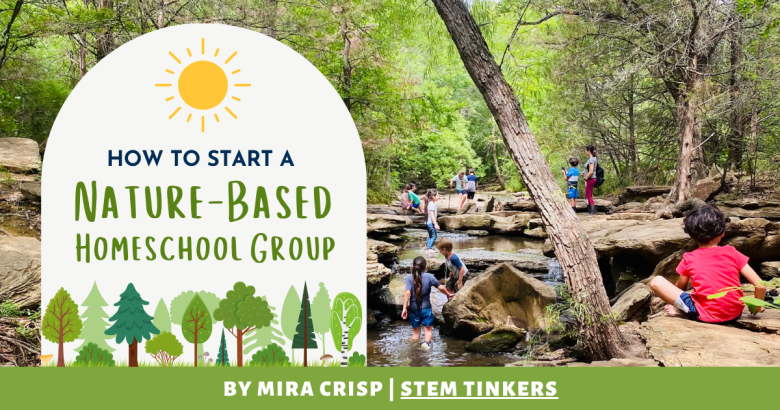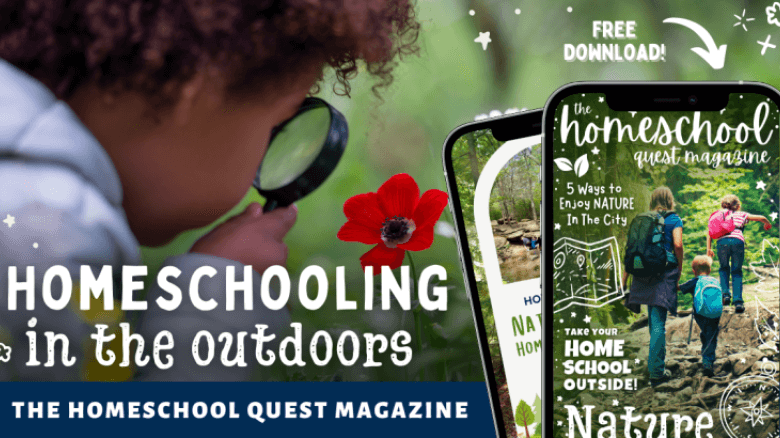By Mira Crisp of STEM Tinkers
Are you feeling lonely on your homeschooling journey? Don't worry, you're not alone.
Building a community and finding your tribe can make all the difference. And this is where a nature-based homeschool group could be just what you need!
Take inspiration from this ambitious mother who realized five years ago that a classroom setting wasn't the best option for her then-5-year-old. So she started her own nature-based homeschool group that has thrived since.
I have always been well aware that kids thrive in nature and I am sure you have, too. We all also know that the great outdoors offers a wealth of benefits, both from a physical and mental perspective.
Outdoor play encourages children to move, explore, and develop their motor skills, making them stronger, healthier, and more resistant.
Then there's the Sun. Sunshine exposure also promotes the production of Vitamin D, which is essential for a healthy immune system and strong bones.
So, how do we encourage our children to get outside and enjoy the beauty of nature? The answer is very simple - just add a few friends to the mix!
Steps To Take Before Starting a Nature Group
I completely understand that starting a homeschool group can be an exciting and challenging experience. However, before you take the leap, it's important to take care of a few essential things first.
Firstly, it's important to have an honest conversation with yourself about your ability and willingness to lead a group of other families.
It's understandable that you may have concerns about leading families who may not share your beliefs or preferences, and it's essential to address these concerns before starting your group.
Once you feel ready, it would be a good idea to discuss your plans with your spouse and a trusted friend.
They can provide valuable feedback about your strengths, and other responsibilities, and help you determine if starting a homeschool group is the right decision for you.
While it may be tempting to seek out opinions from other homeschoolers on social media, it's best to focus on your family's needs and preferences. After all, you will be the one who will need to show up every week, so it's crucial to ensure that your group aligns with your family's values and goals.
Remember, starting a homeschool group is a significant undertaking, but with careful planning and consideration, you can create a safe, inclusive, and supportive community for your family and others.
Define Your Nature-Based Homeschool Group
Once you make the decision to start a nature-based homeschool group, be prepared to address a myriad of inquiries from other homeschoolers. You know they are coming.
How To Structure a Nature Group
Begin by contemplating whether you want your group to be loosely structured and open-ended play or more rigid with specific learning goals.
Next, brainstorm ideas for activities that your own children would enjoy, such as nature walks, birdwatching, plant identification and collection, stargazing, camping, or nature journaling.
Additionally, consider how you will cover the cost of supplies for these activities and whether a regular fee will be required. My group has been covering these fees on an as-needed basis.
Now, would you consider operating your nature group as a co-op where all parents contribute, or would you prefer to take on the sole responsibility of teaching and leading? Will your group welcome both moms and dads or will it be exclusive to one gender?
What age group will your group focus on? I initially established my group without any age restrictions or requirements. However, as time progressed, it naturally narrowed down.
Every year, we adjust this age to accommodate our growing kids. This year we focus on kids 8 to 11 years old. While the youngsters' siblings are always welcome and enjoy playing and learning, we customize our activities to this specific age group.
That's what has worked best for us. You will soon discover what works for your group.
Determine the frequency of meetings, the duration of each session, and potential meeting locations that work best for your family.
Remember, you will be the one required to show up every time. My group meets at a different location every week which allows us to explore new locations and go on adventures.
How To Reach Members That Are a Good Fit for Your Nature Group
When starting a new group, it can be tempting to accept every person who shows interest. Trust me, I’d know.
However, it's important to consider the potential issues that may arise from having a large group with unreliable members who participate sporadically.
Starting with a smaller group of reliable members who actively participate can lead to a more successful and fulfilling group experience for everyone involved.
To ensure your group is cohesive, you should consider the qualities that potential members must possess to join and how often they should attend to remain active.
Moreover, to screen all candidates, what kind of questions should you ask to understand their backgrounds and reasons for joining?
As you start gathering, it will be crucial to prioritize safety and establish guidelines early on for sharing information about the time and location of your meetings.
Should You Affiliate Your Nature Group with National Organizations?
Decide whether you want to align your group with established national nature organizations like Wild+Free, Bearfoot University, or Forest School, and if so, what their requirements for new groups and members are. Some are free, some require fees.
Alternatively, you may choose to remain independent and establish your own requirements and educational philosophy, such as Charlotte Mason, Montessori, or Waldorf.
However, if you opt to market your group under a specific approach, it is important to ensure that you meet members' expectations.
Finally, decide how "outdoorsy" you want your group to be, and whether you are willing to meet in all weather conditions or only when the weather is pleasant.
It is also crucial to screen prospective members to ensure that their “outdoorsy” expectations align with yours.
Creating an official document that addresses all of these questions is a smart move. By putting it in writing, you'll have a solid reference point to refer back to whenever you need it. Trust me, you'll be glad you did!
Gather Your Nature-Loving Tribe
Discovering your tribe among nature-loving homeschoolers can be an exhilarating yet humbling experience. Let's face it, getting people actually to show up is the biggest challenge of any event planning.
Start by sharing your vision for the group with local homeschooling communities and on social media. Be precise about the age group, activities, and locations you plan to organize.
Once you have a few interested families, I strongly urge you to hold an introductory meeting to discuss expectations, safety measures, and group requirements. It would be best to do this without kiddos.
Also, why not invite a couple of close friends to join you for this and the first few meetings as your support system? The new people who do show up for this initial gathering are likely to be your tribe - they made an effort to be there. Listen to their ideas to help shape the group's structure.
Kick Off Your New Nature-Based Homeschool Group
As you prepare to hold your first meeting, remember that you already have all the necessary steps in place. Don't worry if you're not a nature expert - simply pick a location you're familiar with and encourage each family to share their knowledge and interests.
With the right resources, such as the Handbook of Nature Study and the iSeek app, you can easily identify the natural life around you and create a collaborative learning environment. And above all, remember to keep it fun!
Embrace the wonder and excitement of exploration, stay flexible, and enjoy the weather no matter where you are.
Read More!
- Log in to post comments


